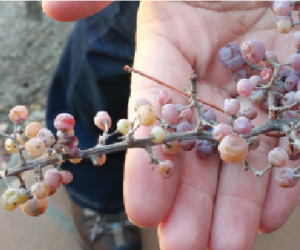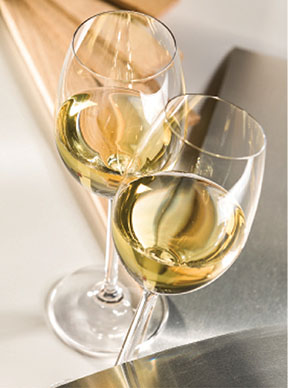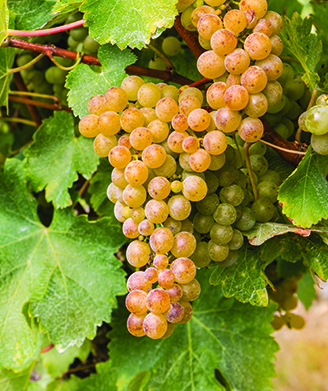
In recent decades Sauvignon Blanc, the green-skinned grape that originated in France, has spread all over the world. New Zealand’s version is probably the most renowned among the newcomers, but there are also quality bottlings made in the United States, Australia, Chile, and South Africa.
The grape’s taste in the glass varies considerably depending on where it’s grown. In France’s Loire region it can carry delicate aromas of grass, anise, flint, and lemon. In New Zealand’s Marlborough region the wine can display powerfully strong flavors of passion fruit and gooseberry. The organic compounds called thiols that contribute to these tropical aromas also help produce Sauvignon Blanc’s famous but notorious “cat pee” smell.
From the late 1980s, New Zealand’s bottlings became the first time the wine achieved real fame from grapes grown outside France. On the back of that success, during the last 30 years or so, increasing numbers of plantings have appeared in other parts of the New World.
However, France still has the most acres. According to a recent article in Forbes magazine, there are about 300,000 acres of Sauvignon Blanc vines grown worldwide. Of that, 86,000 acres are grown in France, followed by about 57,000 acres in New Zealand. Chile, the U.S., and Australia account for the other most significant portions.
In the U.S., it’s probably only in the last five years or so that wines made from Sauvignon Blanc have really picked up in popularity. The COVID-19 pandemic seems to have helped. According to Nielsen, as the pandemic took hold in early 2020 and alcohol sales went up, Sauvignon Blanc had the fastest growing sales of all wine types during the first months of the year, with a nearly 40% increase. Much of that sales increase came from both New Zealand and locally produced Sauvignon Blancs.
This growing popularity in the U.S. is confirmed by one of our expert winemakers — Jeff Cichocki, Director of Winemaking at California’s Bonterra Organic Vineyards. “Sauvignon Blanc is a growing variety for us at Bonterra, and it seems there’s a lot of renewed interest in the variety in general. We have a loyal following and expect the variety to keep growing in popularity and demand, which is very exciting,” he says.
With its increasing popularity, now is a good time for the home winemaker to impress their friends with a homemade Sauvignon Blanc.
New to making Sauvignon Blanc? Don’t worry; we’ve assembled a crew of top winemakers to show you how.
First up, from the Old World, the mother and daughter winemaking team of Annick and Marlène Tinel of Domaine Tinel-Blondelet in France’s Loire Valley. This estate grows nearly 40 acres of vines divided between Sauvignon Blanc, Pinot Noir, and Chasselas. The Sauvignon Blanc is grown in two appellations: Pouilly Fumé and Sancerre.
First up, from the Old World, the mother and daughter winemaking team of Annick and Marlène Tinel of Domaine Tinel-Blondelet in France’s Loire Valley. This estate grows nearly 40 acres of vines divided between Sauvignon Blanc, Pinot Noir, and Chasselas. The Sauvignon Blanc is grown in two appellations: Pouilly Fumé and Sancerre.
Up next, from the New World, we have Jeff Cichocki of Bonterra Organic Vineyards, located in Hopland, Mendocino County, California. Bonterra’s Sauvignon Blanc is sourced from organically farmed vineyards all over the state.
Also from California, Aron Weinkauf is the Winemaker and Vineyard Manager for Spottswoode Wine Estate in Napa County. His Sauvignon Blanc is sourced from estate vines and vineyards in Napa Valley and Sonoma County. Spottswoode has many adoring fans, including wine critic Robert Parker. On the winery’s website he’s quoted: “When the history of Napa’s great vineyards is written, the 40-acre Spottswoode grand cru vineyard will be counted among the finest grand vineyards in the region.”
And from New Zealand, Nikolai St George is Senior Winemaker for Cloudy Bay Vineyards based in Marlborough. Cloudy Bay was one of the first wineries to set up in Marlborough during the mid-1980s. St George says this year’s 2021 Sauvignon Blanc — which is available in the U.S. — is a perfect example of a classic vintage.
400 Years of Winemaking at Domaine Tinel-Blondelet
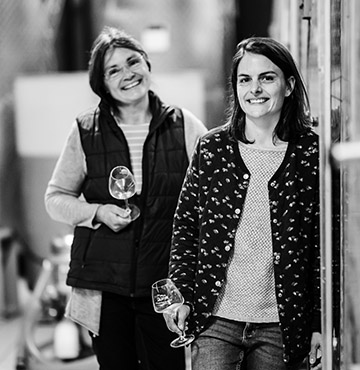
To kick off our lesson, let’s first go to France. Annick and Marlène Tinel are 12th and 13th generation winegrowers who can trace their winemaking pedigree all the way back to the late 16th century and a winegrower named Guillaume Blondelet. So Domaine Tinel-Blondelet’s first winemaker was crushing grapes and making wine several decades before those Pilgrims on the Mayflower had even set sail!
Annick Tinel took over the estate from her parents in 1983. Her co-winemaker and daughter, Marlène, says their Sauvignon Blanc vines in Sancerre are grown in a flinty soil. In the Pouilly Fumé appellation the vines are in kimmeridgian marls, which, she says, is soil dominated by clay and chalk with fossilized oysters and ammonites (extinct marine molluscs).
“We are looking for elegant, fresh, and mineral wine. Our wines are fruity but the aromatic side of Sauvignon Blanc must be well balanced with minerality,” says the younger Tinel, who went on to share many details about the duo’s winemaking style.
Sauvignon Blanc is well known for responding to different soils. Tinel says wine made from their Sancerre-grown grapes is always drier, more mineral, and with a hint of astringency compared to grapes sourced from Pouilly-Fumé, which grows grapes that make a wine with a rounder mouthfeel and saline aromas.
The mother and daughter team are very serious about their Sauvignon Blanc’s sense of place. “Each tank corresponds to a plot. The goal is really to find in our wines the typicity of our terroirs,” says Tinel.
At harvest time, the Tinel-Blondelet team are considering precise picking times plot-by-plot. For their hand-harvested grapes, they take the usual laboratory measurements, including potential alcohol content using a refractometer and chemical measurements of sugar content and acid levels.
At harvest, Tinel says the grape acidity is generally 6.6–6.9 and the pH is 3.2. However, the precise picking date is determined by a sensory judgment of optimal ripeness and sugar-acid balance in the grapes.
“Analyses and figures are not enough,” says Tinel. She says it is very important to taste the grapes to determine if the grapes are “ripe in terms of aromas” because aromatic maturity is independent of sugars and acids.
“It is often necessary to wait a few days more than the ‘technological’ maturity for the grapes to be ripe to make wine!” she says.
At optimal harvest timing, Tinel says the berries are soft enough to depress and when you burst the berries they should display pleasant aromatics. She also advises the importance of watching out for green flavors from excessive amounts of pyrazines, which produce flavors that range from grassy to bell peppers.
The French mother and daughter team are particularly careful about handling their harvested grapes very delicately. The grapes are destemmed but not crushed and then sorted into special double-bottom bins that can drain away any juice sitting in the bottom that might otherwise stagnate and cause spoilage issues.
“We try to work the grapes as delicately as possible so as not to crush the grapes until they get to the press to avoid taste defects like unpleasant herbaceous odors,” said Tinel.
Then the grapes go directly into a pneumatic press where they are pressed slowly at low pressure for about three hours.
Gravity moves the juice from the press to tanks located on the lower level of the winery where it settles for 24 to 48 hours and is then racked.
“The clear juice goes to other tanks and the lees, which have fallen to the bottom of the tank, are filtered through a mud filter,” said Tinel.
All the tanks are stainless steel and temperature-controlled. They usually keep the temperature low enough to delay fermentation for 3–5 days. When fermentation takes place it is allowed to ferment a bit warmer than our other winemakers prefer.
“Our fermentations last about three weeks. We control the temperature at 16 °C (61 °F) then, when the densities become low, almost at the end of the fermentations, we almost stop the temperature control so that the tanks can heat up to 20 to 22 °C (68 to 72 °F).”
One differentiating characteristic of their Sauv Blanc: They like to keep their wine in contact with the fine lees for as long as possible.
“This enriches the wine and gives it more complexity, fat, and body. This also allows our wines to be kept for several years,” says Tinel.
“Finally, we work our wines in a natural way. There are no additions to our wines except a minimal dose of sulfite for storage,” she says.
A cold stabilization follows the completion of fermentation and then most of the Sauvignon Blanc remains in steel tanks before being filtered just before bottling.
“We use very few barrels. Indeed, what people look for in our wines is the fruity side of Sauvignon,” says Tinel. The one bottling that does go into 160-gallon (600-L) barrels touches only 30% new wood.
Tinel says she and her mother have two important tips for a budding Sauvignon Blanc winegrower:
“The most important thing is to have a beautiful, ripe harvest and then good sanitary conditions. You can’t make a good wine without fine grapes. Then, the cleanliness in the cellar and the tanks must also be impeccable,” she says.
Bonterra Vineyard’s Organic Sauvignon Blanc
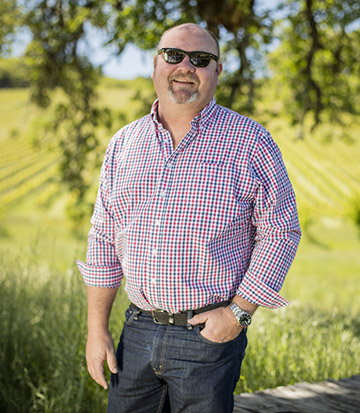
The Sauvignon Blanc made by Jeff Cichocki at Bonterra Organic Vineyards is quite different to the Tinel-Blondelet version.
“At Bonterra, we embrace a New World style for our Sauvignon Blanc and use all stainless steel in our winemaking process. Our wine style focuses on fruit-forward flavors, notably fresh grapefruit,” says Cichocki.
However, much like their French counterparts, Bonterra is very focused on allowing the vineyards to express themselves. “We try not to overcomplicate the winemaking or blending process,” says Cichocki.
The Bonterra winegrower also harvests based on chemistry and taste.
“From a chemistry perspective I look for a Brix range of 21.5 to 23. Additionally, I’d like to see final pH around 3.3–3.4 and acid levels between 6–7 grams,” Cichocki says.
His preferred pH is slightly higher than his French colleagues but he likes his acidity at the same level.
“From a decision making process, tasting the grapes along with the chemistry is important for us. We like to ensure our flavors are not underripe and underdeveloped, or overripe and lacking vibrancy,” says Cichocki.
For California-grown Sauvignon Blanc grapes especially, he said, over ripeness can lead to too much tropical fruit aroma coming through. “At Bonterra, instead, we prefer more citrus and grassy flavors.”
Another factor that influences picking times is the vigor of the vineyard. “If there’s a big canopy with lots of shade, the fruit can stay on the vine longer and develop more slowly. If the vines are receiving a lot of hot California sun, then we’ll often pull those grapes sooner,” says Cichocki.
Unlike our French vignerons who handpick, most of Bonterra’s grapes are harvested by machine and as soon as the grapes arrive at the winery, they are pressed.
“We press immediately upon receiving our grapes and we use a pretty standard press cycle. We yield about 180 gallons (680 L) per ton.”
Cichocki says they centrifuge off the solids, which makes for a nice clean fermentation. “We don’t cold settle. At this stage we hope to achieve a clean juice and get it ready for primary fermentation.”
The fermentation takes place in stainless steel tanks. “I like to ferment at 55 °F (13 °C), which slows down the fermentation. We use some thiol yeast, specifically Vin13 and also X5 yeast,” says Cichocki.
His fermentation, which is cooler than Tinel-Blondelet’s, takes about the same time as the French one; about 2–3 weeks.
“We might see about 1 °Brix drop each day. Sometimes it moves slower. Being organically grown, we don’t have a lot of yeast nutrition available, therefore it’s always a slower ferment for us. We have to be patient!”
Bonterra doesn’t do a malolactic conversion for their Sauvignon Blanc, which could add buttery flavors to a wine that’s meant to be fresh tasting. “Instead, immediately upon primary fermentation, we add SO2.”
Since Bonterra is organic, Cichocki said they are required to use less than 100 ppm total SO2 and typically release the wines with about 25 ppm free SO2.
Bonterra does both a heat and cold stabilization to ensure the wine is stable prior to packaging, and they avoid any oak.
“For our Sauvignon Blanc, we do not use any wood. Our style is to keep the wine fresh and fruit focused and not introduce any flavors or aromas from the wood.”
He said prior to bottling they filter through a crossflow filter. “I have no problem filtering, it’s a necessary part of making wine that doesn’t go through malolactic fermentation. I think it preserves the integrity of the wine over time,” says Cichocki.
Cichocki says any aspiring Sauvignon Blanc winemaker who wants to source grapes from California should look to vineyards in the cooler regions of the state.
“It’s ideal that the grapes have a nice protective canopy from our ample sunlight.”
From there, patience may be the best path forward. “When it comes to the wine, don’t do too much to it! Find out what the vineyard gives you before trying to be too manipulative with the wine,” says the Bonterra winemaker.
Robert Parker Loves Them: Spottswoode’s Sauvignon Blanc
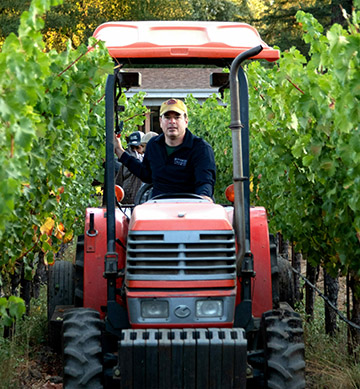
In a warmer part of California, at Spottswoode Wine Estate in Napa County, Winemaker & Vineyard manager Aron Weinkauf makes a very different Sauvignon Blanc to both Bonterra’s and Tinel-Blondelet’s. It’s partly because of his use of oak.
“We are a fairly warm site for Sauvignon Blanc, so we have the ability to achieve riper fruit. I like to think this is why I say we make a stereotypical California Sauvignon Blanc.”
Weinkauf says his wine is rich in texture, but still delineated by acid. He describes a spectrum of aromatics including boxwood and wheat grass, through to citrus, white and yellow peach, cassis bud, and sometimes even melon.
“That balance of all of those components is what is unique about what we can accomplish and then how we frame that in oak and reduction is what we stylistically strive for.”
Like the others, Weinkauf likes to let his vineyards do the talking.
“I always try to work with vineyards that have great natural balance driven by its soils. Then we seek balance throughout the growing season. We want the plant in sync with the seasonal transitions, so we pick with great balance and ripeness. Then if we’ve done our job in the vineyard the winemaking is pretty hands-off.”
For the chemistry side of judging when to harvest, Spottswoode targets 22 to 24 °Brix and likes acidity of 6.0 to 7.5. “We pick according to flavor though, guided by those numbers, and are looking for a complexity and density of character in the fruit when we pick,” Weinkauf says.
When the grapes arrive at the winery, it’s usually straight to a whole cluster press, using an old pneumatic bladder press.
“We may work some with skin contact but this is very variable,” says Weinkauf. “We use a long but fairly aggressive press cycle. We like a little dry extract too.”
Then the must is allowed to settle for 24 hours to separate the juice from the gross lees. Then fermentation of different fractions takes place in steel, oak, ceramic, or cement.
“We ferment in a room held at 58 °F (14 °C). Fermentations take about 30 days.”
French and Hungarian oak are used for the oak fraction, but they don’t overdo it. “I Love oak. I think it is great for lots of wines but . . . it only frames or supports the fruit and acidity. We never want the oak to distract from the energy and verve of the wine,” says Weinkauf.
Spottswoode uses lots of different white wine yeast strains and is constantly playing with them.
“They are very impactful on Sauvignon Blanc and so we’ve trialed most of them and love what each brings to a blend. We are using over five different yeasts each year,” Weinkauf says.
Typically, their Sauvignon Blanc doesn’t go through malolactic fermentation (MLF) but it does go through a heat and cold stabilization.
“We do a modified version of both. We do think the consumer usually appreciates a wine that is not clouded or loaded with small crystals,” he says.
Spottswoode filters all of their wines, including Sauvignon Blanc, usually just before bottling.
“We love the guarantee of a good filtration and find that the polish and precision of the filtration is a great component of the linearity and drive of the mouth and aromatics, and find that there is no significant change in the body and texture.”
In fact, Weinkauf went on to say he feels the texture and richness of a filtered wine can be better than that of an unfiltered version.
At bottling, total sulfur for Spottswoode’s Sauvignon Blanc is at levels between 60–85 ppm.
As for tips for home winemakers, the Spottswoode winemaker says the key is to work with good fruit. But he has another useful thought: “Winemaking is about intent. Know what you are aiming for.”
Cloudy Bay: New Zealand’s Classic Sauvignon Blanc
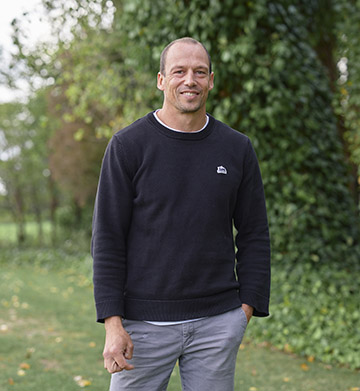
In New Zealand, Nikolai St George is Senior Winemaker for one of the first wineries to set up in the now famous Marlborough region. Cloudy Bay Vineyards opened for business in the 1980s. They make two distinctly different Sauvignon Blancs: One that is machine harvested and predominantly fermented in stainless steel tanks, which is the focus for this article, and another that is hand-harvested and fermented in oak.
St George says New Zealand Sauvignon Blanc evolved from a series of fortunate mistakes. Essentially, he says, most of the country’s Sauv Blanc vineyards are descendants of three vines brought over from California in the early 1970s (those vines originated from the legendary Château d’Yquem 150 years prior). These cuttings just happened to make great wine and no other clones imported and grown in New Zealand have been as successful.
As a professional winemaker for 27 years now, St George regards Marlborough Sauvignon Blanc as the flagship wine of New Zealand.
“It encompasses everything about the country: It is fresh, vibrant, aromatic and pure, much like a lot of New Zealand. Very few wineries around the world can even come close to the style and it is New Zealand’s number one exported wine by a long way.”
Interestingly, as New Zealand’s vines mature — as they reach 10 to 15 years old — he’s seen significant changes in the wine.
“I have seen a real increase in palate weight and fewer yield fluctuations. We also see less overt fruit as well. A great New Zealand Sauvignon will have texture and weight, which really takes the wine to the next level.”
The vines still produce fruit with the aromatic intensity that made it famous. “It usually displays three to four distinct characteristics to varying degrees: Mineral, tropical, herbal, citrus, and sometimes black/red currant aromas,” says St George.
Tropical notes vary from fresh fruits like pineapple, guava, or passion fruit to baked notes, he says. These aromatics are dictated by the vintage and also where the fruit is grown.
Cloudy Bay sources most of its grapes around the “Golden Mile,” which are some of the older vineyards in Marlborough where the soils are “true alluvial,” meaning born from river deposits with large rocks, gravel, and silt, St George explains. They are also undulating so the fruit ripens faster on the humps and slower in the hollows.
“These sites are warm, low vigor, and early, which means our wines show more mineral, citrus, and tropical aromas and less herbacity,” he says. Canopy management also contributes to boosting tropical and citrus flavors while limiting herbal influences, characteristics Cloudy Bay is after with its Sauvignon Blanc.
“We also crop around 30% less than most wineries so this helps give us extract and body. Our wines are naturally brighter and tighter than a lot of other Marlborough styles, as we only use free run juice. This keeps the pH naturally lower and helps the wines age gracefully,” says St George.
The kiwi winemaker says his approach to winemaking is about purity and producing unique, rather than perfect, wines.
“A wine is more interesting with imperfections. There is nothing worse than a wine that has been worked and polished so much that it becomes perfect and boring,” he says.
When it comes to deciding when to harvest, Cloudy Bay is looking for a riper style than some wineries, says St George.
“So around 13% potential (alcohol), which means 21.5 to 22.5 °Brix. We have the luxury of being able to harvest a lot of our fruit very quickly, which is great as a lot of vineyards are ready at the same time.”
When the grapes arrive at the winery they allow them to have some skin contact and then press to tank.
“We are one of the few wineries that still settle our juices. This has a very large positive influence on aromatics. We have done numerous trials on this and can prove it,” says St George.
Eighty percent of the free run comes out before the membrane press is even turned on. “The press cycle we use has minimal rotations to avoid solids and phenolics and is pretty fast. We then monitor what has been extracted and make a press cut at about 700 L/T.”
Up to fermentation, St George uses a number of different techniques.
“We make a press cut and only use the free run, which is cold settled in tank then racked 24–72 hours later. We then warm and inoculate with selected yeast. This is a yeast we have selected over the years and we continually fine-tune the recipe. Some yeast boost aromatics and tropical notes and some are big on mouthfeel.”
Cloudy Bay integrates varying degrees of fine grape lees prior to and also during fermentation. They also integrate oak to help with mouthfeel and texture.
“We ferment mainly in stainless steel and about 5% in oak (foudres) or barrels. Oak maturation is becoming a more important part of what we do. We are also starting to play with more cement as well,” St. George says.
Fermentation temperature plays a significant role with Sauvignon Blanc as even small changes of temperature can have a big influence on the amount of thiols produced and the aromatic intensity. This is an area home winemakers can play around with to find which results they prefer.
Prior to bottling, St George uses a crossflow filter on the wine, which he believes actually helps increase aromatics. “Peynaud (a famous French enologist) said something like ‘filtration never had any negative influence on quality’ and when using crossflow technology properly I tend to agree. Filtration helps bring out aromatic potential, purity of flavor, and stops anything untoward ruining your wine,” says St George.
They use sulfite, but their Sauv Blancs have a naturally low pH — the 2021 vintage is 3.14 — so 25 ppm of free SO2 is enough to maintain stability. “By the time the wine gets to the Northern Hemisphere it will have about 15 ppm of sulfur — just enough to hold its freshness.”
They also do a heat and cold stabilization. “Over 90% of what we sell is internationally to many different markets. We cannot afford instability issues and our consumers will not accept this. If done properly stabilization has very little influence on quality,” says St George.
Much like Spottswoode’s Wein-kauf, St George advises the home winemaker to understand what style of Sauv Blanc he or she wants to create and then choose the grapes carefully. “Sauvignon Blanc aromas and texture are heavily influenced by soil type, climate, and vine age,” he says.
With this particularly versatile grape you can aim for a lot of different results. But whether it’s the powerful, tropical flavors of some New World Sauvignon Blancs that you seek, a more elegant, tightly structured French style, or something in-between with oak influences — hopefully our four experts have provided inspiration for your next harvest.


